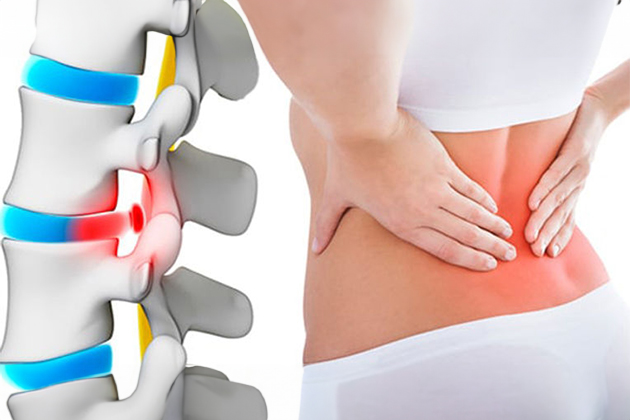
Cervical Disc Herniation
Structure and Functions of the Spine
Our spine consists of a total of 33 vertebrae and is divided into 5 sections:
- 7 cervical (neck) vertebrae
- 12 thoracic (mid-back) vertebrae
- 5 lumbar (lower back) vertebrae
- 5 sacral vertebrae (forming the sacrum)
- 4 coccygeal (tailbone) vertebrae
The sacral and coccygeal vertebrae are fused and do not move. The three primary functions of the spine are:
- Facilitating body movement
- Supporting respiratory functions
- Protecting the spinal cord and nerve structures
Our spine contains over 13 million neurons, 220 ligaments, more than 120 muscles, and over 100 joints. The spinal cord, protected by the spine, weighs approximately 35 grams. The spine allows movements such as bending forward and backward, rotating right and left, and rotating on its own axis.
Risk Factors for Cervical Disc Herniation
- Age: Discs tend to degenerate more with age, especially in individuals over 40.
- Genetic Factors: A family history of cervical disc herniation can increase the risk.
- Gender: Men have a slightly higher risk of cervical disc herniation compared to women.
- Smoking: It can negatively affect circulation, making it difficult to nourish the discs.
- Occupational Factors: Heavy lifting jobs can increase the risk of cervical disc herniation.
- Inactivity: Lack of physical activity can weaken the neck muscles.
- Obesity: Excess body weight creates additional pressure on the spine and discs.
- Poor Posture: Poor posture habits can cause the neck vertebrae and discs to be positioned incorrectly.
- Trauma and Accidents: Blows or trauma to the neck can cause disc injuries.
- Rheumatoid Arthritis: Rheumatic diseases can cause inflammation of the neck vertebrae and discs.
Symptoms
Symptoms of cervical disc herniation can vary in severity and form in each individual:
- Neck Pain: The most common complaint is pain in the neck area.
- Shoulder Pain: Pain can start from the shoulders and extend to the arm and shoulder region.
- Numbness in Arms and Hands: Pressure on nerve roots can cause numbness or tingling.
- Muscle Weakness: Pressure on nerve roots can lead to muscle weakness.
- Headaches: Pain can spread from the back of the neck to the top of the head.
- Urinary and Bowel Problems (Rare): In advanced stages, it can press on the spinal cord.
Diagnosis
The diagnosis of cervical disc herniation is made based on the patient’s clinical symptoms and imaging methods. The most commonly used method is magnetic resonance imaging (MRI), which provides detailed information about the condition of the disc, its location, and its effect on nerve roots. Additionally, computed tomography (CT), X-rays, and electromyography (EMG) tests can aid in diagnosis.
Treatment
Non-Surgical Treatment:
- Use of a cervical collar
- Bed rest
- Pain relievers and muscle relaxants
- Exercise and physical therapy
Surgical Treatment:
- Microdiscectomy: A minimally invasive procedure using a surgical microscope. The patient receives general anesthesia, and special retractors are used to reach the spine. The damaged disc is removed, and sometimes a fusion procedure is performed.
- Laminectomy: A procedure where bone plates are removed to provide more space for the spinal cord.
Postoperative Care
- Follow the doctor’s recommendations
- Pay attention to wound care
- Start with low-impact activities
- Avoid heavy lifting
- Use a neck pillow or cervical collar
- Regular check-ups
Full recovery after cervical disc herniation surgery includes a period of 3 months or more. During this time, it is important to maintain a healthy lifestyle, follow the doctor’s recommendations, and not neglect regular check-ups.
Frequently Asked Questions
A cervical hernia occurs as a result of the degeneration or injury of the discs in the cervical spine. Discs serve as cartilaginous structures that protect the spinal cord and nerve roots. A cervical hernia occurs when the gel inside the discs leaks or protrudes, putting pressure on the nerve roots and causing various neurological symptoms.
Boyun fıtığının temel patolojisi, servikal omurga disklerinin sıkışması veya yırtılması sonucu ortaya çıkar. Bu durum, disklerin normal işlevlerini yerine getirememesine ve çevreleyen sinir dokularına baskı yapmasına yol açar. Disklerin iç kısmında yer alan jelin sızması, enflamasyona ve sinir tahribatına neden olabilir. Bu nedenle, boyun fıtığı hastalığının mekanizması hem mekanik hem de inflamatuar bileşenleri içerir.
Symptoms of a cervical hernia include neck pain, numbness, and tingling in the shoulder, arm, or hand, weakness in the arm or hand, headaches, and restricted neck movements. In some cases, pain and numbness may spread to the legs due to pressure on the nerve roots.
Diagnosis of a cervical hernia is based on the patient’s complaints and physical examination findings. Imaging methods such as MRI (Magnetic Resonance Imaging), CT (Computed Tomography), and X-rays are used to confirm the diagnosis and determine the location and severity of the hernia. An EMG (Electromyography) test can also be used to determine the extent of nerve damage.
The recovery process after cervical hernia surgery varies depending on the type of surgical intervention performed and the patient’s overall health. Postoperative physical therapy and rehabilitation are important to accelerate the recovery process and maintain spinal health. Postoperative precautions include adhering to the exercise program recommended by the doctor, taking prescribed medications for pain management, and avoiding heavy lifting or strenuous activities. Regular follow-ups and adherence to the doctor’s instructions are also crucial during the recovery process.

